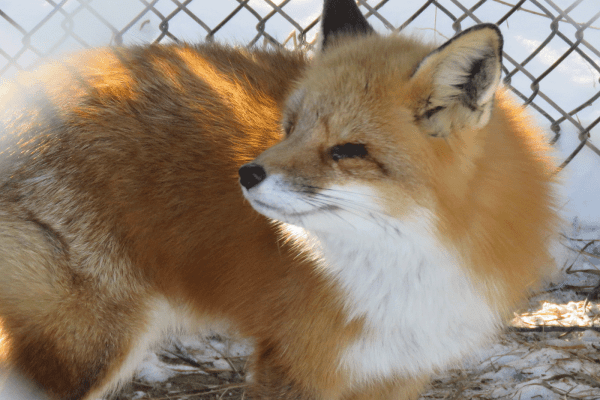By the time you read this month’s column, we will have turned the clocks ahead an hour, and despite any late season snowstorms, we know that spring is right around the corner. In looking through some of Carleen Cote’s old articles (dating from the 1990s), I thought I’d share one that is still applicable all these years later:
“Warmer days are becoming more frequent. This winter was very kind. We only had to shovel snow from our 25 pens three or four times. The major inconvenience was the icy paths to the pens – there was much slipping and sliding, but most of the time we managed to stay upright. The supply of sand we had stored in buckets in the cellar came in handy to provide traction on the paths.
Because the pens are constructed with plastic-covered wire, we cannot wear creepers in the pens. They would cut into the plastic, defeating the purpose of the plastic — to prevent the wire from rusting and to prolong the life of the pens.
The wildlife that spent the winter at the Center include late babies that were not ready to be released last fall, who will soon be released. All the pens and equipment will be cleaned and sanitized. Necessary supplies have been ordered, the milk has been purchased, and the incubators are ready for the spring babies that will soon be arriving.
Squirrels will be the first, followed by baby raccoons. We never know what will arrive or how many. Every year is different.
Most people who find baby squirrels are happy to pass them on to a rehabber. However, there are those who go on the internet to find information on how to care for a wild animal in order to keep it. Anyone can post anything on a website; not all postings are correct. Some folks tell us they just couldn’t take the animal away from their kids. There is more to raising a baby squirrel than just giving it food!”

Fox being cared for at Duck Pond Wildlife Center. Photo by Jayne Winters
As Carleen noted in her article, typically some critters will be held over the winter for release the following spring. Reasons vary, but often fall admissions aren’t strong or well enough to survive the colder temperatures and reduced food sources of the winter months. Don is always particular about his release sites, mindful of habitat and freshwater availability, both of which may not be accessible after autumn weather sets in. Last spring, the triplet bobcats, 3 red foxes, and 10 fawns were successfully transported and released back into the wild. This year, Don has a couple of opossums, three red foxes, one gray fox, and two gray squirrels to return to their rightful homes.
Admissions have slowed down during the winter, but there are still calls from folks worried about animals that appear to be injured, sick, or struggling to survive. Don continues to take them in but transfers some rescues to other rehabbers who have graciously offered to provide assistance to help keep critter care at Duck Pond manageable. Please check the following websites to see if there is a rehabber near you: www.mainevetmed.org/wildlife-rehabilitation or www.maine.gov/ifw/fish-wildlife/wildlife/living-with-wildlife/orphaned-injured-wildlife/index.html. Donald Cote operates Duck Pond Wildlife Care Center on Rte. 3 in Vassalboro. It is a nonprofit, State-permitted rehab facility supported by his own resources and outside donations. Mailing address: 1787 North Belfast Avenue, Vassalboro ME 04989 Phone: (207) 445-4326. Please note that the prior wildlifecarecenter email address is not being monitored at this time.
—by Jayne Winters, Natural Resources Council of Maine member from South China, Maine
Critter Chatter also appears monthly in the Town Line newspaper.










Leave a Reply